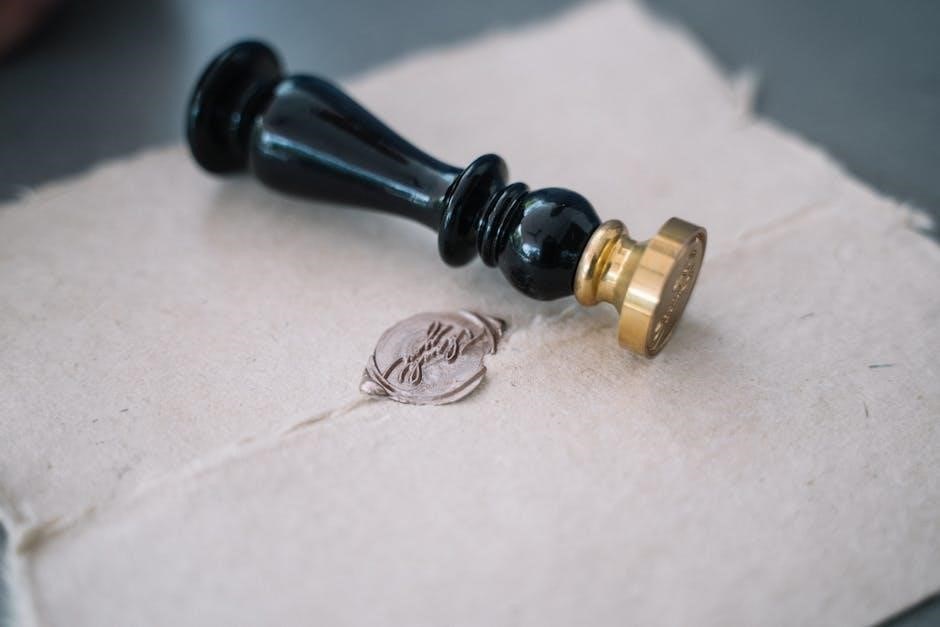Welcome to the WA PocketScope Manual, your comprehensive guide to understanding and using the Welch Allyn Halogen PocketScope Set․ This manual covers both Ophthalmic and Diagnostic models, providing detailed operating instructions, maintenance tips, and troubleshooting solutions to ensure optimal performance and longevity of your device․
1․1 Overview of the WA PocketScope
The WA PocketScope is a lightweight, portable diagnostic instrument designed for medical professionals․ It combines an ophthalmoscope and otoscope in a compact design, making it easy to carry in a lab coat pocket․ The set includes a halogen light source for true tissue color and illumination, ensuring accurate diagnoses․ Durable and ergonomic, the PocketScope is ideal for both general and specialized medical use, providing reliable performance for clinicians and healthcare providers․ Its user-friendly design and long-lasting battery handle make it a versatile tool for daily medical examinations․
1;2 Importance of the Manual for Proper Usage
Reading and following the WA PocketScope Manual is essential for proper usage and maintenance․ It provides detailed instructions on operating the device, troubleshooting common issues, and maintaining its optical and functional integrity․ The manual ensures users understand safety precautions, optimal handling techniques, and how to extend the device’s lifespan․ By adhering to the guidelines, clinicians can maximize the PocketScope’s performance, ensuring accurate diagnoses and reliable service․ Proper usage, as outlined in the manual, is crucial for both patient care and equipment longevity․

Components of the Welch Allyn PocketScope
The Welch Allyn PocketScope includes a lightweight handle, optical lenses, halogen light source, and interchangeable ophthalmoscope and otoscope heads, designed for portability and versatility in diagnostics․
2․1 Ophthalmic and Diagnostic Model Sets
The Welch Allyn PocketScope is available in two distinct sets: the Ophthalmic and Diagnostic models․ The Ophthalmic set is tailored for eye examinations, featuring a high-resolution ophthalmoscope for detailed retinal visualization․ The Diagnostic set includes an otoscope for ear examinations, with a halogen light source ensuring clear imagery․ Both models come with a rechargeable handle, interchangeable heads, and a lightweight design, making them ideal for both general and specialized medical use․ These sets are designed to meet the diverse needs of healthcare professionals, ensuring accuracy and reliability in diagnostics․
2․2 Battery Installation and Handle Setup
The Welch Allyn PocketScope operates using AA alkaline batteries or a rechargeable battery handle․ To install batteries, open the handle’s compartment, insert the batteries according to the polarity markings, and close it securely․ For the rechargeable handle, connect it to the provided charger until fully charged․ The ergonomic design ensures comfortable handling during examinations․ Proper battery installation is essential for consistent illumination and device functionality․ Always refer to the manual for specific instructions to ensure safe and optimal setup of your PocketScope․ This ensures reliable performance during diagnostic procedures․

Operating Instructions
This section provides essential guidance on using your WA PocketScope, including power controls, illumination settings, and zoom features, to ensure optimal performance during diagnostic procedures․
3․1 Power Controls and Illumination Settings
To operate the WA PocketScope, press the power button to turn it on․ Adjust the illumination settings using the brightness control knob for optimal visibility․ The halogen light provides true tissue color and consistent illumination․ Use the zoom feature to enlarge images for detailed examination․ Ensure the device is turned off after use to conserve battery life․ Regularly check and replace batteries as needed to maintain performance․ Refer to the manual for specific instructions on power management and illumination adjustment for both ophthalmic and diagnostic models․
3;2 Adjusting Brightness and Focus
Adjust the brightness using the control knob located on the handle to achieve optimal illumination․ For focus adjustments, use the focus wheel to sharpen the image․ The halogen light ensures true tissue color, while the zoom feature enhances viewing details․ Turn the focus wheel clockwise or counterclockwise until the image is clear․ Ensure the device is at the correct working distance for accurate focus․ Proper adjustment of brightness and focus is crucial for precise diagnostics․ Refer to the manual for detailed guidance on refining these settings for both ophthalmic and diagnostic examinations․
3․3 Using the Zoom Feature
The WA PocketScope features a zoom function for detailed examinations․ To use the zoom, locate the control slider on the handle and move it to adjust magnification․ This allows for closer inspection of specific areas without losing clarity․ The zoom feature enhances diagnostic accuracy, enabling practitioners to identify subtle details․ Ensure the device is properly focused before zooming for optimal results․ This function is particularly useful during ophthalmic and diagnostic procedures, providing a clear and magnified view of the examination area․

Maintenance and Care
Regular maintenance ensures optimal performance․ Clean optical lenses with a soft cloth, avoiding harsh chemicals․ Store in a protective case and handle with care to prevent damage․
4․1 Cleaning Procedures for Optical Lenses
Proper cleaning of the optical lenses is essential for maintaining clarity and performance․ Use a soft, dry microfiber cloth to gently wipe away any smudges or debris․ Avoid using alcohol, chemicals, or water, as these can damage the coatings or surfaces․ For stubborn smudges, dampen the cloth slightly with distilled water, but ensure it is thoroughly wrung out to prevent moisture from contacting the lenses․ Regular cleaning prevents contamination and ensures precise diagnostic results․ Always store the PocketScope in a protective case when not in use to minimize exposure to dust and potential scratches․
4․2 Storage Guidelines to Prevent Damage
Proper storage is crucial to maintain the Welch Allyn PocketScope’s functionality․ Store the device in a soft, protective case to prevent scratches and dust accumulation․ Avoid exposing the PocketScope to extreme temperatures, humidity, or direct sunlight, as these can damage the optical and electrical components․ Ensure the device is clean and dry before storage to prevent contamination․ Keep it away from heavy objects that could cause accidental damage․ Regularly inspect the case for wear and tear to ensure it continues to provide adequate protection․ Proper storage habits will extend the lifespan of your PocketScope and ensure reliable performance․
4․3 Handling Tips for Longevity
To ensure the longevity of your Welch Allyn PocketScope, handle it with care․ Always grasp the device firmly but gently, avoiding excessive pressure on the optical lenses or the handle․ Clean the instrument regularly using the recommended cleaning solutions to prevent contamination․ When not in use, store the PocketScope in its protective case to safeguard against scratches and damage․ Avoid exposing the device to harsh chemicals, extreme temperatures, or direct sunlight, as these can compromise its functionality․ By following these handling tips, you can maintain the precision and reliability of your PocketScope for years to come․

Troubleshooting Common Issues
This section addresses common problems such as dim or flickering light, focus adjustment difficulties, and battery life concerns․ It provides practical solutions to ensure optimal functionality․
5․1 Diagnosing Dim or Flickering Light
If the light on your WA PocketScope appears dim or flickers, check the battery installation first․ Ensure batteries are correctly inserted and not expired․ Clean the optical lenses regularly, as dirt or debris can reduce light intensity․ Inspect the bulb for damage or loosening, and tighten any connections․ If issues persist, consult the troubleshooting section for further guidance or refer to the manual for replacement instructions․ Proper maintenance ensures consistent illumination for accurate diagnostics․
5․2 Resolving Focus Adjustment Problems
If the WA PocketScope focus is blurry or misaligned, ensure the diopter setting is adjusted correctly for your vision․ Clean the optical lenses thoroughly, as dirt or smudges can affect clarity․ Check for loose connections or misaligned parts in the focus mechanism․ If issues persist, refer to the manual for calibration steps or contact professional support․ Proper focus adjustment is crucial for accurate diagnoses, so addressing these issues promptly ensures optimal performance․ Regular maintenance can help prevent such problems from arising․
5․3 Addressing Battery Life Concerns
If your WA PocketScope experiences short battery life or fails to power on, first ensure the batteries are installed correctly and connections are clean․ Use only high-quality, compatible batteries to avoid drainage issues․ Avoid overcharging, as this can reduce battery longevity․ If the device still doesn’t function, try resetting the handle or recalibrating the power settings․ For persistent issues, refer to the manual or contact customer support․ Proper battery care is essential for maintaining reliable performance and extending the lifespan of your PocketScope․

Accessories and Attachments
Enhance your WA PocketScope experience with compatible handles, chargers, and optional attachments designed to improve functionality and portability․ Explore accessories that meet your diagnostic needs․
6․1 Compatible Handles and Chargers
The WA PocketScope is designed to work seamlessly with a range of handles and chargers, ensuring reliable power and portability․ The rechargeable handle is compatible with both Ophthalmic and Diagnostic models, offering extended battery life․ It supports both alkaline and rechargeable batteries, providing flexibility for different usage scenarios․ The charger is designed for easy USB connectivity or docking station use, making it convenient to power up your device on the go․ These accessories are crafted to enhance your diagnostic experience, ensuring uninterrupted performance and ease of use․
6․2 Optional Attachments for Enhanced Functionality
Enhance your WA PocketScope experience with optional attachments designed to expand its diagnostic capabilities․ The Otoscope head allows for detailed ear examinations, while the Retinoscope attachment aids in assessing refractive errors․ Additionally, a Transilluminator attachment is available for nasal and oral cavity inspections․ These accessories are engineered to integrate seamlessly with the base unit, ensuring optimal performance․ Users are encouraged to refer to the specific attachment manuals for detailed setup and usage instructions to maximize functionality and diagnostic accuracy․

Safety Information
Exercise caution when handling the WA PocketScope to avoid damage․ Avoid exposure to harsh chemicals or extreme temperatures, which may compromise its performance and longevity․
7․1 Precautions for Safe Operation
Always handle the WA PocketScope with care to prevent damage․ Avoid exposing the device to harsh chemicals, extreme temperatures, or direct sunlight, as this may compromise its optical clarity and functionality․ Clean the lenses only with recommended solutions to maintain precision․ Store the PocketScope in a protective case when not in use to prevent scratches or accidental damage․ Never disassemble the device, as this could void the warranty or cause irreversible harm․ Follow all safety guidelines to ensure safe and effective operation․
7․2 Warnings for Proper Handling
Handle the WA PocketScope with care to avoid damage․ Never expose the device to harsh chemicals, extreme temperatures, or direct sunlight, as this may harm its optical components․ Use only recommended cleaning solutions to prevent lens damage․ Store the PocketScope in a protective case to avoid scratches․ Avoid disassembling the device, as this could void the warranty or cause irreversible damage․ Always follow the manufacturer’s guidelines for proper handling to ensure the longevity and reliability of your PocketScope․

Warranty and Calibration
The WA PocketScope is backed by a 5-year warranty, covering parts and labor․ Regular calibration is recommended to maintain accuracy and performance․ Schedule calibration annually․
8․1 Understanding the 5-Year Warranty
The WA PocketScope is protected by a 5-year warranty, ensuring coverage for parts and labor due to manufacturing defects․ This warranty provides peace of mind, safeguarding your investment in the device․ It does not cover damage resulting from misuse or improper maintenance․ Regular maintenance and adherence to guidelines are essential to uphold warranty terms․ The warranty period begins from the date of purchase, offering reliable protection and enhancing the longevity of your PocketScope․ For detailed warranty conditions, refer to the official documentation or contact customer support․
8․2 Scheduling Calibration Services
To maintain the accuracy and performance of your WA PocketScope, regular calibration is essential․ Calibration ensures precise optical and diagnostic functionality․ Contact Welch Allyn authorized service centers to schedule calibration, typically recommended every 5 years or as needed․ This service is covered under the 5-year warranty, ensuring your device remains in optimal condition․ Proper calibration prevents operational issues and extends the lifespan of your PocketScope․ Always use certified services to guarantee adherence to manufacturer standards and maintain the reliability of your diagnostic tool․

Downloading the Manual
Access the official WA PocketScope Manual digitally by visiting the Welch Allyn website or authorized distributors․ Download the PDF version for easy reference and offline use․
9․1 Accessing the Digital Version
To access the digital version of the WA PocketScope Manual, visit the official Welch Allyn website or authorized distributor sites․ Navigate to the support or resources section, where you can search for the specific model․ Once located, click the download link to retrieve the PDF file․ Ensure you have the correct model number, such as the Welch Allyn Halogen PocketScope Set, to find the accurate manual․ If prompted, log in to your account or create one for access․ The digital manual is ideal for quick reference and easy searching of specific topics․
9․2 Printing the Manual for Offline Use
To print the WA PocketScope Manual for offline use, download the PDF version from the official Welch Allyn website or authorized distributors․ Ensure your printer is set to high-quality settings to maintain clarity․ Print all pages or select specific sections as needed․ For best results, use standard letter-sized paper and adjust margins to fit the content․ Store the printed manual in a secure location for easy access during clinical use or training scenarios․ This ensures you always have a backup reference, even without internet connectivity․

Additional Resources
Explore online support, FAQs, and training videos for the WA PocketScope․ Visit the official Welch Allyn website for comprehensive guides, troubleshooting tips, and instructional materials․
10․1 Online Support and FAQs
Visit the official Welch Allyn website for dedicated online support and a comprehensive FAQs section․ These resources provide quick answers to common questions, troubleshooting tips, and detailed guides for optimal use of your WA PocketScope․ Additionally, you can access instructional videos, user manuals, and calibration information to ensure your device operates at its best․ For further assistance, contact customer support directly through the website or refer to the provided contact details in the manual․
10․2 Training Videos and Tutorials
Enhance your understanding of the WA PocketScope with official training videos and tutorials available on the Welch Allyn website․ These resources provide step-by-step guidance on operating, maintaining, and troubleshooting your device․ From basic setup to advanced diagnostic techniques, the videos cover a wide range of topics to help you master the PocketScope․ Additionally, tutorial guides are available for download, offering visual and written instructions to ensure you get the most out of your diagnostic tool․ These materials are designed to support both new and experienced users․
11․1 Summary of Key Points
This manual has provided detailed guidance on the WA PocketScope, covering its components, operation, maintenance, and troubleshooting․ Key points include proper battery installation, adjusting brightness and focus, using the zoom feature, and cleaning optical lenses․ Additionally, it emphasizes safe handling, storage guidelines, and warranty details․ By adhering to these instructions, users can ensure the device functions optimally, providing accurate diagnostics for both ophthalmic and general medical use․ Regular maintenance and adherence to safety precautions will extend the lifespan of your PocketScope․
11․2 Final Tips for Optimal Usage
For the best experience with your WA PocketScope, always handle it with care and store it properly․ Regularly clean the lenses and ensure batteries are fresh․ Familiarize yourself with the zoom feature for detailed examinations and adjust brightness for clear visibility․ Refer to troubleshooting tips if issues arise․ Stay updated with the latest resources and support materials for enhanced functionality․ By following these guidelines, you’ll maximize the performance and longevity of your PocketScope, ensuring reliable diagnostics for years to come․
